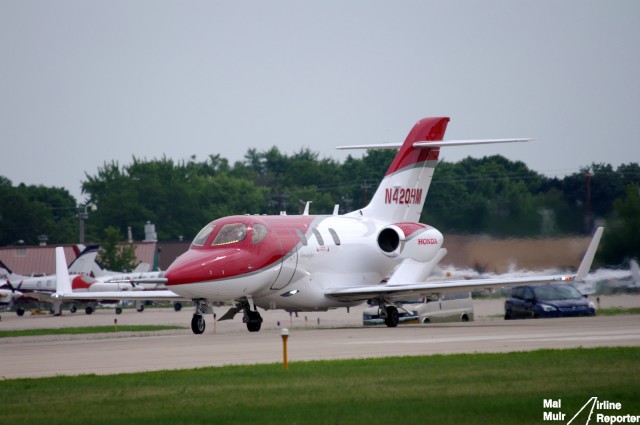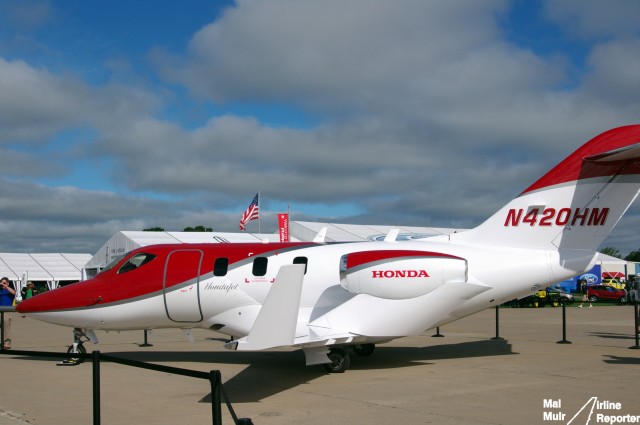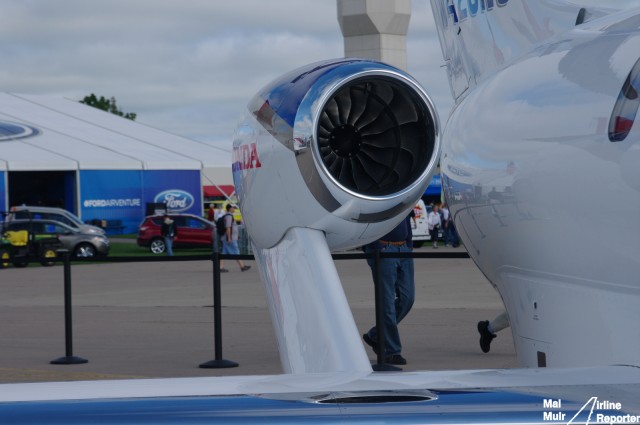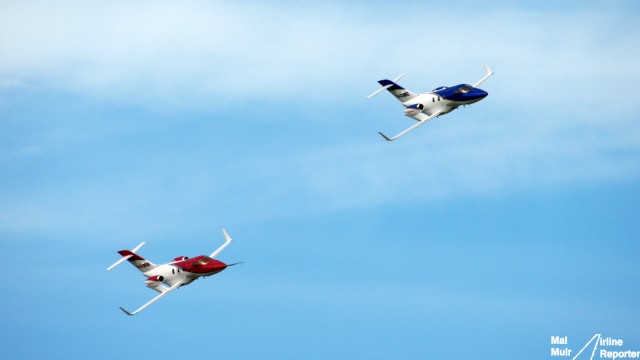
One of the HondaJets prepares for takeoff at EAA Airventure in Oshkosh – Photo: Mal Muir | AirlineReporter.com
An unusual-looking business jet made an appearance at OshKosh 2013 and was followed in by a second identical aircraft. What were these unfamiliar aircraft? They were the third and fifth FAA-conforming HA-420 HondaJets, appearing for the first time together.
A uniquely-designed aircraft, the HondaJet will enter the small business jet market once the final rounds of FAA certification and testing are completed, estimated in 2014. Designed to carry six people (1 or 2 crew, along with 4 or 5 passengers), this small, light jet is a mixture of cutting-edge design, state-of-the-art technology, and a few new concepts to make it an expected class-leading aircraft.
The two examples flown to AirVenture were frame numbers 3 & 5, of a 6 aircraft-test fleet. Frame number 3, which joined the test program in 2011, is being used for mechanical systems testing, while aircraft number 5 has the first production-fitted interior and should anchor the final tests. Seeing the two aircraft side-by-side at Oshkosh on the very first day attracted quite a large crowd – including me.

HondaJet #3 (N420HM) on display at EAA AirVenture in Oshkosh – Photo: Mal Muir | AirlineReporter.com
’œEAA AirVenture Oshkosh has special significance for me,” said Honda Aircraft President and CEO Michimasa Fujino. “This event is where I introduced the proof-of-concept HondaJet to the world for the very first time. It was truly the beginning of Honda’s exciting venture into aviation. I am very excited that EAA AirVenture Oshkosh has once again provided the setting for the first public appearance and demonstration flight of not one, but two FAA-conforming HondaJets.’

CEO of HondaJet Michimasa Fujino kneels down to sign an autograph on a HondaJet cap. Photo: Mal Muir | AirlineReporter.com
Fujino started as design project leader of the Honda Aircraft program back in 1986 and, almost 11 years later, he drew the first concept for the HondaJet (apparently on the back of a calendar). But what makes this aircraft design so visually unique? The obvious answer is the engines.
Typically the engines on business jets are mounted on the rear of the aircraft, near the tail, with all of the support systems taking up precious cabin space. For Fujino, that would not do!

Over-the-wing engine mounts (OTWEM) make the HondaJet a unique aircraft – Photo: Mal Muir | AirlineReporter.com
The HondaJet’s two engines are instead mounted on the wings, but not in a typical fashion. Unlike many commercial airliners, the HondaJet has them mounted over the wing.
The over-the-wing engine mounts (OTWEM) not only give back precious cabin space, but also reduce noise while increasing fuel efficiency. Add to this the all-composite body, with a natural laminar-flow wing design, state-of-the-art navigation (Garmin G3000), and the latest technology in the passenger cabin (such as electrochromatic windows like the Boeing 787) and you have one killer aircraft.

Two FAA-conforming HondaJets do a formation fly-by at EAA AirVenture in Oshkosh – Photo: Mal Muir | AirlineReporter.com
The best part of the HondaJets were when they completed their first dual demonstration flights to an excited crowd at AirVenture. As I stood there looking at them, watching them conduct the multiple passes, it made me wonder: How can such a cutting-edge aircraft manage to sneak in under most peoples’ radar?
The bigger question: if this is a success, what else can Honda build? I can’t wait to find out.
Comments are closed here.
I didn’t realize the engines were mounted on the wing! When you look quickly, especially at the first two pics you’d think the engines were on the fusulage, like a CRJ. Wild!